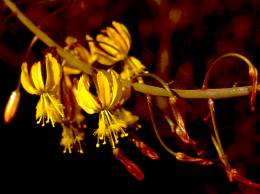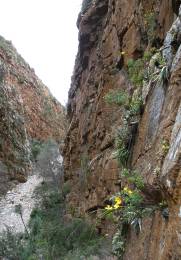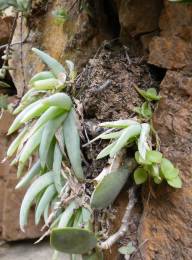Bulbine cremnophila
Bulbine cremnophila Van Jaarsv.
Family: Asphodelaceae
Common names: Baviaanskloof cliff bulbine (Eng.); Baviaanskloof kranskopieva (Afr.)
Introduction
Bulbine cremnophila is a cliff hugger growing in small clusters with hanging leaves and yellow flowers during spring. It thrives in cultivation in containers or on living walls in light shady conditions.

Description
Description
Plants grow in dwarf clusters (3-8 heads) with leaves in a rosette, up to 120 mm high and 100 mm in diameter. Roots grey, cylindrical (terete). Leaves softly succulent, up to 7 in a rosette, drawn together but curving downwards, elongated spear-shaped (linear-lanceolate), 60-100 × 10-15 mm, channelled above, and keeled below (cymbiform), grey-green (glaucous) and faintly tranlucent, covered with powdery bloom, the point (apex) sharp, bearing a little point (mucronate), reddish pink. The inflorescence is a raceme 200-400(-450) mm long, 17-35-flowered in the upper (distal) half. The bracts are small, triangular and drawn to a point (acuminate), 5 × 1 mm. The flower stalk is 15-18 mm long. The flower (perianth) is about 8-10 mm in diameter with 6 floral leaves (tepals) radiating from a central point (stellate), orange-yellow and in two whorls, the outer ones elliptic 7 × 2 mm, the inner ones egg-shaped, 6 × 2.5 mm, becoming reflexed and drooping. The stamens are up to 5 mm long, densely bearded in the upper half. Ovary rounded and up to 1.5 mm in diameter. Fruit are small, rounded, 3 × 2.5 mm and seeds are 2 mm in diameter, black.

Conservation Status
Status
Classified as Rare (Raimondo et al. 2009), this species is well protected by its cliff-face habitat. It is also well established in cultivation (ex situ conservation).

Distribution and habitat
Distribution description
Bulbine cremnophila is confined to vertical cliffs of narrow, shady kloofs (mainly eastern and western aspects) of the Baviaanskloof Mountains of the Eastern Cape, west of Hankey. Plants are firmly rooted in crevices. Temperatures are high on summer days (35-40°C). The average daily maximum temperature is about 25°C and the average daily minimum about 10°C. Winters are cooler, but frost is absent. Rainfall occurs throughout the year, but with a peak in spring and summer, ranging from 400-500 mm per annum (thundershowers or cyclonic winter rain). Bulbine cremnophila grows at an altitude of about 400-1000 m in Gamtoos Thicket (Mucina et al. 2005). Associated species include Cotyledon tomentosa var. tomentosa, Crassula perfoliata var. minor, Crassula perforata, Gasteria rawlinsonii and Albuca cremnophila. The geology consists of quartzitic sandstone.
Derivation of name and historical aspects
History
Bulbine cremnophila was named by the author in 2000 from plants collected earlier in the Baviaanskloof in the Eastern Cape. The specific epithet `cremnophila' is composed of Greek cremnos, cliff, and philos, loving, pertaining to its cliff-dwelling habitat.
The genus Bulbine consist of about 80 species, grows widespread in southern Africa and is particularly common in the winter rainfall region of the Western and Northern Cape. Its greater distribution includes Africa and Australia. This species is closely related to Bulbine rupicola of the southwestern parts of the Eastern Cape, also often found growing in small crevices on cliffs. It is easily distinguished by its smaller green leaves which do not curve down.
Ecology
Ecology
Flowering during spring. Flowers are pollinated by insects. The seeds are light and wind-dispersed.
Uses
Use
Used mainly as a pot plant or occasionally grown out-of-doors in rockeries.
Growing Bulbine cremnophila
Grow

B. cremnophila is easily grown in containers. It requires partial shade for best results. It can be grown in hanging baskets or rockeries in Thicket Gardens (Van Jaarsveld 2010). Water well but allow soil to dry out before watering again (spring to autumn). B. cremnophila can also be grown in miniature succulent gardens thriving in an environment together with other succulent plants. It is easily grown in a sandy, humus-rich soil. Use a general succulent mix such as 2 parts sand, 1 part garden loam and 1 part compost. Add ample bone meal, and plants can be fed with an organic fertilizer. Propagation is easy by cuttings or division. Cuttings are best rooted in sand; the best time is during spring or summer. Keep them partially shaded. Once rooted, they can be transferred to containers. Plants can also be grown from seed planted in a well drained succulent soil. Broadcast on the medium and cover with a thin layer of sand 2-3 mm thick. Keep moist. Germination is usually within 3 weeks.
Plants are relatively disease-free but succumb rapidly to fungal rot when kept too moist. The aloe ring fungus (Uromyces sp.) can be troublesome but is easily treated with a fungicide. When grown as a pot plant, it is best to replant every second or third year in fresh soil at the end of the resting season (early spring).
References
- Eggli, U. 2001. Succulenten-Lexicon. Band 1. Einkeimblättrige Pflanzen (Monocotyledonen). Springer, Berlin.
- Leistner, O.A. (ed.). 2000. Seed plants of southern Africa: families and genera. Strelitzia 10. National Botanical Institute, Pretoria.
- Mucina, L. & Rutherford, M.C. (eds) 2006. The vegetation of South Africa, Lesotho and Swaziland. Strelitzia 19. South African National Biodiversity Institute, Pretoria.
- Raimondo, D., Von Staden, L., Foden, W., Victor, J.E., Helm, N.A., Turner, R.C., Kamundi, D.A.& Manyama, P.A. (eds) 2009. Red List of South African plants. Strelitzia 25. South African National Biodiversity Institute, Pretoria.
- Van Jaarsveld, E.J. & Van Wyk, A.E. 2000a. Five new cremnophilous taxa from semi-arid regions in southern Africa. Aloe 36,4: 71-74.
- Van Jaarsveld, E.J. 2010. Waterwise gardening in South Africa and Namibia. Struik, Cape Town.
Credits
Ernst van Jaarsveld
Kirstenbosch National Botanical Garden
January 2011
Plant Attributes:
Plant Type: Succulent
SA Distribution: Eastern Cape
Soil type: Sandy
Flowering season: Spring
PH: Acid
Flower colour: Yellow
Aspect: Shade, Morning Sun (Semi Shade)
Gardening skill: Average
Special Features:
Horticultural zones








Rate this article
Article well written and informative
Rate this plant
Is this an interesting plant?
Login to add your Comment
Back to topNot registered yet? Click here to register.